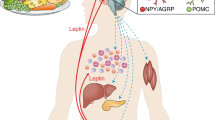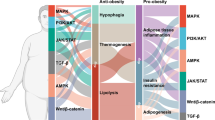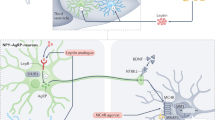Abstract
Obesity results from a chronic imbalance between energy intake and energy expenditure. Environmental factors, such as the increased availability of high caloric food or the decreased need for physical activity, contribute to its development and their influence is amplified by genetic predisposition. In recent years remarkable progress has been made in the understanding of the pathophysiology of obesity. Although most of the insights into the regulation of energy balance have been obtained in rodent models, the rare clinical cases of monogenic obesity provided evidence for the importance of several of these mechanisms in humans. The identification of leptin as a factor originating from adipose tissue and informing the brain about the status of energy reserves firmly established the concept of long-term regulation of body fat stores. The disappointing therapeutic results with leptin in obese patients could be explained by the fact that during evolution this hormone developed rather as a starvation signal than as an adiposity signal. It is conceivable that the pharmacological interference with mechanisms downstream of leptin, for example with the melanocortin pathway, might be therapeutically more promising. The discovery of new molecular mechanisms involved in the regulation of the differentiation and proliferation of adipocytes and the elucidation of their paracrine and endocrine functions have changed the traditional view of adipose tissue as an inert depot for triglycerides. The identification of new uncoupling proteins could modify the current concepts of the regulation of thermogenesis in humans. The remarkable progress in the identification of novel targets involved in the regualtion of energy balance should have a positive impact on the search for new antiobesity agents.
This is a preview of subscription content, access via your institution
Access options
Subscribe to this journal
Receive 12 print issues and online access
$259.00 per year
only $21.58 per issue
Buy this article
- Purchase on Springer Link
- Instant access to full article PDF
Prices may be subject to local taxes which are calculated during checkout
Similar content being viewed by others
Author information
Authors and Affiliations
Corresponding author
Rights and permissions
About this article
Cite this article
Hofbauer, K. Molecular pathways to obesity. Int J Obes 26 (Suppl 2), S18–S27 (2002). https://doi.org/10.1038/sj.ijo.0802124
Published:
Issue Date:
DOI: https://doi.org/10.1038/sj.ijo.0802124
Keywords
This article is cited by
-
Glycine enhances expression of adiponectin and IL-10 in 3T3-L1 adipocytes without affecting adipogenesis and lipolysis
Amino Acids (2018)
-
Obesity and Cancer: Concepts and Challenges
Indian Journal of Surgical Oncology (2015)
-
Miglitol increases energy expenditure by upregulating uncoupling protein 1 of brown adipose tissue and reduces obesity in dietary-induced obese mice
Nutrition & Metabolism (2014)
-
Branched chain amino acids and metabolic regulation
Chinese Science Bulletin (2013)
-
Inhibition of pancreatic lipase by berberine and dihydroberberine: an investigation by docking simulation and experimental validation
Medicinal Chemistry Research (2013)



